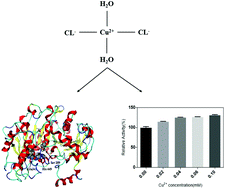Exploring the binding interaction between copper ions and Candida rugosa lipase†
Abstract
The wide range of applications of copper have caused widespread concern about its toxicity. However, few studies have reported the mechanism of the binding interaction between copper ions and digestive enzymes, which play an important role in physiological health and industrial production. In this study, the effects of copper ions on the conformation and activity of Candida rugosa lipase (CRL) were evaluated by isothermal titration calorimetry (ITC), multiple spectral techniques, molecular simulation and enzyme activity assays. The results showed that copper ions can be combined with lipase, the binding affinity constant (K) was (2.91 ± 0.619) × 10−3 M−1, the binding process was a spontaneous process, and the main force was the hydrophobic force. Rather than increasing the hydrophobicity of the amino acid microenvironment of CRL, the spectral methods demonstrated that copper can also make the protein peptide bond structure compact, changing its secondary structure. In addition, molecular simulation results showed that copper ions opened the “lid” of the CRL and entered the active center, which consequently changed the conformation of the CRL molecule. Structural changes may cause changes in enzyme activity. The increased activity of CRL with the addition of copper ions was verified by enzyme activity assay. In summary, copper showed an effect on CRL at the molecular level, which means its toxicity should receive more attention.

- This article is part of the themed collection: Toxicology Research Recent HOT articles


 Please wait while we load your content...
Please wait while we load your content...